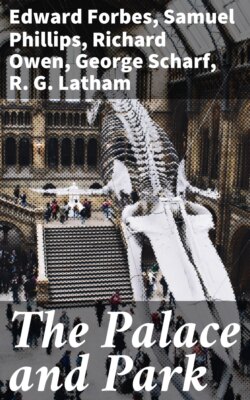Читать книгу The Palace and Park - Edward Winslow Forbes - Страница 11
На сайте Литреса книга снята с продажи.
THE GERMAN MEDIÆVAL COURT.[13]
ОглавлениеThis small Court is devoted exclusively to examples of Gothic art and architecture in Germany, and, taken with the English and French Mediæval Courts—which we shall presently reach—gives an excellent idea of the style and character of architecture in these three countries during the Middle Ages. Such remarks as are required to explain the transition from the Romanesque and Byzantine to the Pointed style of architecture, we shall defer until we find ourselves in the Mediæval Court of our own country. We, therefore, without preface, conduct the visitor from the gallery of the Byzantine Court, through the side arches, directly into the German Mediæval Court. The large doorway in the centre at once attracts attention. This is cast from a celebrated church doorway at Nuremberg, and is especially worthy of notice. On the wall to the right is a doorway leading into the Byzantine Court. This is not copied from any one particular example, but is a composition displaying the elements of the German style. The equestrian statue of St. George is from the Cathedral square at Prague, a work of the 14th century. The seven round bas-reliefs at the top of the doorway, representing scenes from the life of Christ, are fac-simile copies of the originals by Veit Stoss, at the Church of St. Lawrence, in Nuremberg. On either side of this doorway are two monuments, of Bishops Siegfrid von Epstein and Peter Von Aspelt, opposite to which are the fine monuments of Albert of Saxony, and of Bishop Von Gemmingen; all of these are cast from the originals, in Mayence Cathedral. Above the arches, and all round the Court, is a small arcade, the capitals, brackets, and other monuments of which are taken from various German churches, but more especially from the Cathedral of Cologne. Immediately over the arches through which we have entered, and between the columns of the arcade, are four bosses with the symbols of the Evangelists, also from Cologne Cathedral.
[13] See “Handbook to the Mediæval Court,” by M. Digby Wyatt and J. B. Waring.
Plan of the German Mediæval Vestibule.
Passing through the Nuremberg doorway, in the centre, we see immediately before us, and over the arches leading to the nave, eight dancing mummers, from the Town-hall at Munich; they are represented as exhibiting before an audience, probably at some civic festival, and are full of grotesque drollery. Beneath the mummers are placed consoles or brackets, from the hall of Gurzenich, at Cologne, remarkable for the humour displayed in their conception. On the wall to the right are three large reliefs, from the church of St. Sebald, at Nuremberg. They are the work of Adam Krafft, and represent:—1. The Betrayal of our Saviour; 2. The Mount of Olives; 3. The Last Supper;—and in their execution show great power and much less stiffness than is generally found in Mediæval works. Adam Krafft was an excellent sculptor, who flourished at the close of the 15th century. His works, which are chiefly to be found at Nuremberg, possess great merit both in their search after truth and the unusual manual ability they display. Immediately beneath these reliefs is another by the same artist, taken from the Frauen-Kirche, or Church of our Lady, at Nuremberg. It represents an Adoration of the Virgin, and shows even more vigorous handling than the other three. On the other side of the adjoining doorway, from the Monastery of Denkendorf, in Wurtemburgh, is another piece, representing the “Coronation of the Virgin,” also by Krafft. The monument beneath is from Munich, and is of the 16th century. On the left-hand wall, next to the Nuremberg door, is a bas-relief of “Justice with the Rich and Poor,” by Veit Stoss, from the Town-hall at Nuremberg. Above and below this are others by Krafft. The upper, the “Meeting of Christ and St. Veronica,” from the Via Crucis, Nuremberg; the lower, another “Coronation of the Virgin,” from the Frauen-Kirche, Nuremberg. Under this last are two ascribed to Albert Durer—a “Circumcision,” and “Christ teaching in the Temple;” and on the other side of the doorway, leading into the English Mediæval Court, is the celebrated garland representing the triumph of the Church, by Veit Stoss, from the church of St. Lawrence, at Nuremberg, which deserves especial examination as one of the master-pieces of that sculptor, and on account of its very peculiar arrangement. Other subjects in this Court present excellent examples of German Mediæval Art down to the time of Peter Vischer, whose works evince an evident influence derived from the Renaissance School of Italy, at the close of the 15th and at the commencement of the 16th centuries.
We now emerge into the Nave, and turning to the left, find ourselves in front of
